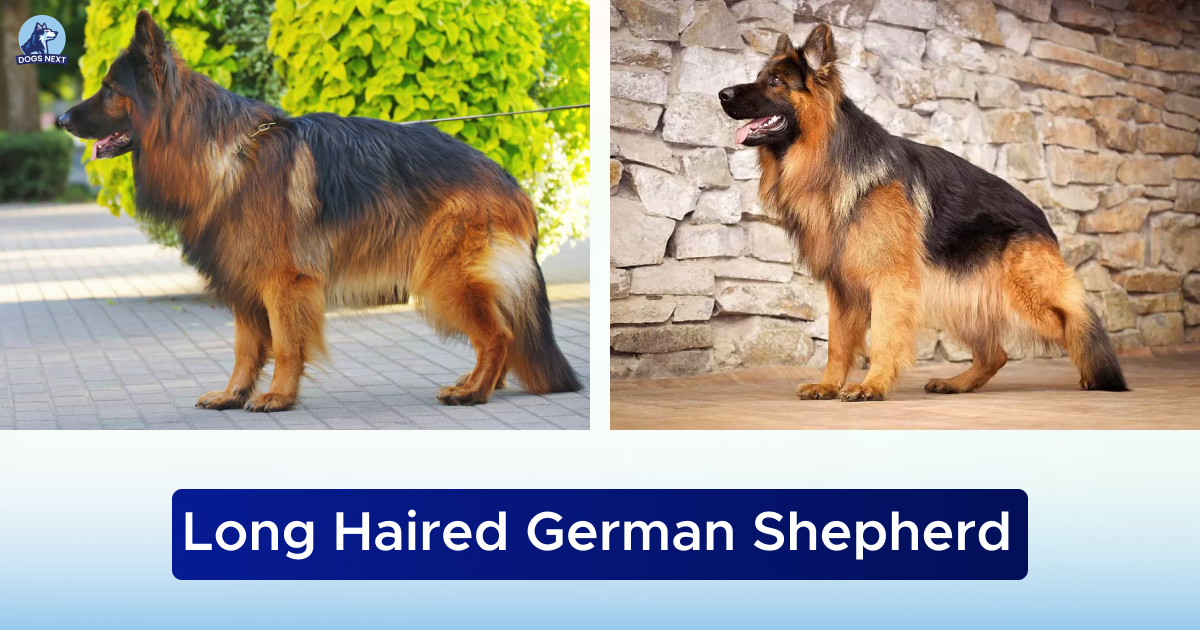Since the American Kennel Club’s list of favorite breeds was published in 1959, the German Shepherd has topped the list for years. In 2019, it is currently ranked as the second most popular breed.
According to the American Kennel Club, German Shepherds are the second most popular dog in the United States. Their affiliation with Germany caused them to decline somewhat after WWII. However, they have gained significant popularity since then.
It is more difficult to find a typical German Shepherd with a mild personality and an outgoing personality. They prefer spending time with humans overworking and are much less work-oriented than an average German Shepherd.
Table of Contents
Long-Haired German Shepherd vs Short Haired Comparison
| Long Haired GSD | Short Haired GSD | |
| Size: | 22-26 inches tall | 22-26 inches tall |
| Weight: | 50-90lb | 50-90lb |
| Coat: | Single layered, long, silky | Double layered, woolly undercoat and dense outer coat |
| Color: | Black and tan, black, red and black, sable, black and silver, and grey | Black and tan, black, red and black, sable, black and silver, and grey |
| Lifespan: | 10-13 Years | 10-13 Years |
| Temperament: | Loyal, athletic, and confident | Loyal, athletic, confident, and a good worker |
| Intelligence: | Very intelligent | Very intelligent |
| Socialization: | Good with other dogs but needs socialization | Good with other dogs but needs socialization |
| Destructive Behavior: | Prone to jumping, barking, and chewing | Prone to jumping, barking, and chewing |
| People Skills: | Great with family | Great with family but may be aloof with strangers |
| Initial Purpose: | Companion animal | A working dog bred initially to herd sheep |
| Energy Levels: | Highly energetic | Highly energetic |
Short-Haired German Shepherd vs Long-Haired German Shepherd Differences
Similarities:
- Their traits include loyalty, protection, energy, intelligence, and athleticism.
- In both varieties, the males grow larger than the females, despite being similar in size.
- A two-hour daily walk is required for both dogs.
- Both types of GS can experience separation anxiety.
- While looking after their families, they are both protective and possessive.
- Having Hip dysplasia and heart disease is the same risk factor for both conditions.
- Both should live similar lifespans as long as they’re purchased from responsible breeders.
Differences:
- Long-Haired German Shepherds’ coats can reach up to two inches in length compared to Short-Haired German Shepherds’ one-inch coats.
- It has an outer coat and an undercoat, both of which are double-coated. Undercoats, or guard coats, are usually worn beneath medium-length coats. Undercoats are usually around two inches long in German shepherds with long hair. A long, single-layer coat is the only coat that some long-haired GSDs have, and there is no undercoat.
- German Shepherds without undercoats are not accepted into the AKA’s exhibitions because they are considered defective.
- In general, Short-Haired German Shepherds are more suited to working outside than inside, because of their double coat that protects them from cold and is waterproof.
- It is more likely that Short-Haired German Shepherds behave aloofly toward strangers due to their aptitude for work.
Where it came from
Breeding a unique breed fascinated Max von Stephanitz, the first brewer of long-haired German Shepherds. A short-haired male dog named Hector formed the basis for the German Shepherd breed when he bought it at an exhibition at the end of the nineteenth century.
The long hair was considered a fault by him because he thought the dog’s performance would be affected. The offspring had an inherited recessive gene, so he couldn’t prevent them from appearing. Eventually, the breeder’s opinion turned out to be wrong.
The long-haired German Shepherd Club got started at the end of the 20th century. These dogs were included in the standard in 2010. A long-haired Shepherd with an undercoat is officially a separate breed type since 2011.
What you’re wearing
There are lots of similarities between black German Shepherds and other German Shepherds. Their size is similar to that of a purebred German Shepherd and they have the same build.
A male weighs approximately 65 to 90 pounds, while a female weighs between 50 and 75 pounds. Before adopting one, consider your space before acquiring one of these medium-to-large dogs. The larger these dogs are, the more people forget to consider before adopting them, and later regret their decision.
They are between 22 and 26 inches tall. Both males and females should follow this rule. There isn’t much difference in height between them, but the males tend to be bulkier.
There is no color difference between black and white German Shepherds. It’s pretty common for German Shepherds to have some black on them. It’s all black on German Shepherds.
Except for the coloration difference, their coats are pretty much the same. Keeping themselves clean and warm is made easier by the double coat on their bodies. There’s no denying the fact that these dogs are built for work, and that shows in their behavior.
Furthermore, crossbreeding is not responsible for it, as some misinformation might claim. Most German Shepherds end up with this color simply because it is a rare color. Selected breeding sometimes encourages its appearance, as it only appeared recently.
Solid black coats are now considered dominant, despite being once thought to be recessive. There aren’t a lot of dogs with this gene, so it doesn’t get covered up by other genes.
Dark eyes are always a sign of these dogs. Rare breeds like Huskies usually have blue eyes, which means they have other breeds in their pedigree.
Besides the color, the black German Shepherd’s body is just as similar to that of its black and tan cousins in terms of the way he looks and acts. German Shepherds usually have upright ears, but sometimes they have floppy ears as adults.
Temperament and Behavior of the Long-Haired German Shepherd
Short hair varieties tend to have a similar temperament to this variety. Loyalty and protection are two of their strongest characteristics. Separation anxiety is also a common symptom.
Work capability is the main difference. They are not suitable for work because of their beautiful long hair, for which they were bred. Rather, they are always eager to please their owners and are friendly with strangers.
Exercise makes a difference. In spite of their energy and enthusiasm, they do not enjoy walks in cold weather as much as their short-haired counterparts do. In the event of freezing temperatures or rain, they cannot perform well. Consider your location when deciding whether to adopt a long-haired GSD if you live in an area that experiences cold and wet weather.
Despite their obedience, these dogs need constant contact with their owners’ families. Due to this very fact, they can become wonderfully fun, playful, and entertaining indoor dogs who are a pleasure to own.
Toys and family members are two things that they like to engage with. Aside from that, these dogs don’t only show immense bravery when their owners are in danger, but they are also extremely protective of them. Besides the peace of mind they bring, this nature makes them very good playmates and excellent babysitters for children.
Daily exercise is essential for German Shepherds with long hair. Their energy should be channeled into something stable. The best thing they can do is play fetch or Frisbee.
How long do German Shepherds live and how healthy are they
Short-haired German Shepherds have a lifespan of approximately 9-13 years, almost equaling the life expectancy of their long-haired counterparts. The same diseases can also affect them. Eczema, hip dysplasia, and epilepsy are some of the issues that may arise.
Genetic anomalies such as dysplasia can be inherited, whereas breeding techniques can cause other defects. A variety of hereditary problems can arise as a result of careless breeding.
It is important that you and your dog receive veterinary care on a regular basis. For detecting different health conditions, X-rays, blood tests, and other methods are required during a physical examination.
German Shepherds: How Much Do They Cost?
There can be a great deal of difference between breeders when it comes to the price of a Long-Haired German Shepherd.
The coats of some breeds are more valuable than others, but some breeders will advertise them for higher prices because they are rarer.
It is important to find a breeder whose puppies are both reputable and not overpriced.
A puppy from a Long Haired German Shepherd breed will cost you anywhere from $500 to $1500.
| Age | Price |
| Puppy | $500-$1500 |
| Adult | $300-$500 |
| Adoption | $75-$350 |
German Shepherd Long-Haired Diet
Finding a food that is suitable for German Shepherds can be challenging due to their joint problems and allergies.
Especially in puppyhood, your dog needs food with low protein content. A puppy’s joints can suffer from joint problems if he eats too much protein.
A joint health dog food should also contain glucosamine and chondroitin, which are both beneficial for the maintenance of healthy joints in your dog.
You should look for a hypoallergenic dog food that contains a unique protein for your Long Haired German Shepherd if your pet is exhibiting symptoms of food allergies. Generally, diets with only a few ingredients are less likely to cause allergic reactions because they contain fewer ingredients.
Allergies to foods include the following:
- Grass
- The wheat crop
- Yeast
- Farming
- The egg
- It’s beef time
- The chicken
- Meat
- It’s a lamb
- The fish
German Shepherds with long hair: How to take care of Them
The German Shepherd breed is undemanding due to its long hair. Ideally, they should be kept on private property in an aviary. It is necessary to provide long daily walks to the dog if it lives in an apartment.
It requires a lot of care, despite its thick fur.
There is continuous shedding in this breed of long-haired dogs. There is a lot of shedding at the beginning of fall and spring. The most important thing you need to get started is a good vacuum cleaner for when you bring one of these fluffy friends into your home.
Because of the length of their fur, these adorable dogs are also susceptible to matting. It is imperative that you brush them frequently in order to prevent matting.
Ideally, you should brush them twice or three times a week, although you can brush them every day. Brush their coat thoroughly with a long-toothed brush to remove any tough mats or tangles. In addition to brushing twice a week, shepherds should be brushed every day during shedding season. A brush should also be used to brush the belly’s undercoat.
You should avoid scratching their skin, however. It’s easy to cause them to itch while combing them since they don’t have an undercoat. Be gentle but thorough when brushing.
The skin of your pets should be given particular attention when grooming them.
A German Shepherd with long hair is prone to dry skin and dermatitis if its coat is overwashed. A mild shampoo should be used when taking a bath once a month.
A wet cloth or special wipes will help you clean the coat of dirt at other times.
To prevent damaging the blood vessels in the hands, claws should be trimmed regularly with special claw clippers. It is recommended to wipe them with a wet cloth between clippings.
After feeding, it is important to check the shepherd’s teeth. By brushing them with special products, you can prevent tartar from forming.
Inspect your dog daily as follows:
- The eyes. A water-soaked cloth can be used to remove secretions from their outer edges to their inner edges.
- Make sure your nose is moist. Vets should be contacted if crusts form.
- You shouldn’t have any wounds on your paws.
- Make sure your mouth and lips aren’t wounded or cracked with secretion.
- You know, ears. In the ear sockets, wet cotton swabs should be used to wipe them. Detecting unpleasant odors, secretions, or hair growth in your ears before they disrupt wax drainage will also help prevent disruptions.
Approximately 2 hours are required to complete Shepherd’s walk. A two-time daily feeding schedule is followed by adults.
Furthermore, you should ensure your dog receives timely vaccinations and treatment against parasites.
German Shepherds with long hair grow to what size?
A long-coated German Shepherd can’t be raised without research because you love them. It is important to get the dog’s adult size straight from the beginning in this case.
It takes them about 26 inches to grow to 26 inches (males) and 24 inches to grow to 24 inches (females). In general, males weigh 66-88 lbs and females 49-71 lbs, almost the same as short-haired coat types. The length of their coat doesn’t affect their height or weight.
The ears and backs of the legs of long-coated German Shepherds are covered in fur tufts between the paws, hindquarters, and tails. Feathering is the process of doing this. Especially if they don’t have an undercoat, or are open-coated, their fur looks shinier than short-haired dogs.
If you want to keep your pet comfortable, you must ensure that you have a full-sized dog crate like Midwest Homes for Pets iCrate from Online and a good dog bed. As your pup grows, you can move the divider to make more room in this size 48″ crate. It creates a safe and secure home for your pup.
It is true there are many good dog beds on the market, but I have found the Big Barker Orthopedic Bed to be both affordable and durable, and the perfect solution to reduce joint and hip pain caused by shoehorning an 88-pound dog into a standard, medium-sized bed. It comes with a 10-year guarantee and is used by my German Shepherd.
Besides size and weight, color has a big impact on your dog’s appearance. The only difference between “coaties” and “standard” coaties is the coat length. German Shepherds with long coats are much less likely to be found in show lines since they are bred out more thoroughly.
Black and tan German Shepherds are more common among working lines than those with black and red markings (typical of show lines).
As your puppy matures, his color may change. There is a recessive hair length gene in the dog, but an exotic color gene can also be found that can interfere with hair growth as the puppy grows. There are times when lighter fur sheds and does not regrow.
Frequently Asked Questions
How Would You Rate Their Temperament?
There are many reasons for the popularity of the German Shepherd, including its temperament. A short-haired dog and a long-haired dog have similar temperaments.
There is a big difference between the Short-Haired German Shepherd and the Long-Haired German Shepherd in terms of their suitability for working.
Their minds may be more focused and they may be aloof with strangers. As no scientific differences exist between the breeds, this difference is mostly anecdotal. Breeders focus on certain characteristics in their lines to produce the best dogs.
German Shepherds with long hair shed more than those with short hair.
Shedding is common in both varieties. When shedding seasons occur in spring and fall, short-haired dogs shed extensively. The shed rate of long-haired shepherds is consistent throughout the year. Furniture, clothes, and other household items are not messed up by the shed of long-haired animals.
German Shepherds with long hair should be bathed how often?
It is only necessary to bathe once a month, and only light shampoo should be used. Whenever possible, use a damp cloth or a special wipe to remove dirt from the coat. Overwashing long-haired German Shepherds can cause dry skin and dermatitis.
What is the undercoat of a longhaired GSD?
It is not true that German Shepherds do not have an undercoat, as is commonly believed. Their undercoat is shorter and less dense than their topcoat, although they are double-coated.
Conclusion
German Shepherd breeders of the long-haired variety aren’t nearly as numerous as those of the short-haired varieties. Several rescue organizations around the world offer GSDs for adoption if you’re interested in adopting one.
The courageous and intelligent nature of these animals hides the fact that they are affectionate and loving.
They are loyal, intelligent, and capable of great things, which makes them one of the world’s most popular breeds.

I’m David, an expert contributor and writer, with two furry friends of my own, I know the challenges of raising and caring for dogs. From training to nutrition and health, my goal is to provide valuable insights and advice to help create strong bonds and happy, healthy lives. Find me in Twitter.




